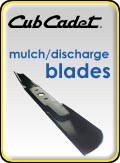 In the world of lawn mower cutting decks and blade types, the decision comes down to just two varieties. The first of these is the more versatile of the two, known as a mulching blade or a “3-in-1” model. The alternative, and perhaps a more standard blade, is the high-lift blade. This blade performs more standard mowing tasks, including creating clippings that can be easily discharged or move to a storage bag for effective removal from the lawn. Both blade types aren’t without their merits, and they’ll likely find a home with different kinds of residential and commercial landscapers who fertilizer and maintain their outdoor areas in slightly different ways.
In the world of lawn mower cutting decks and blade types, the decision comes down to just two varieties. The first of these is the more versatile of the two, known as a mulching blade or a “3-in-1” model. The alternative, and perhaps a more standard blade, is the high-lift blade. This blade performs more standard mowing tasks, including creating clippings that can be easily discharged or move to a storage bag for effective removal from the lawn. Both blade types aren’t without their merits, and they’ll likely find a home with different kinds of residential and commercial landscapers who fertilizer and maintain their outdoor areas in slightly different ways.
So, What is a Mulching Blade?
Mulching blades were designed by companies like Cub Cadet to be a bit better at breaking down lawn clippings and circulating them back into the turf during typical lawn maintenance. For this reason, these blades are designed slightly differently than their high-lift alternatives. Instead of focusing on “lifting” the air and the clippings during mowing, and funneling them into discharge or retention, mulching blades focus more on creating a fine layer of evenly distributed clippings that return nutrients to the lawn.
Their design makes them more efficient for those who prefer natural fertilization, but less efficient for customers who prefer to simply bag clippings and dispose of them elsewhere. That’s because the mulching blade, also known as a 3-in-1 blade, isn’t designed to lift air or clippings. When not used for mulching, the design causes this blade to inefficiently retain clippings and unevenly distribute them via a side discharge.
Though many mowers come with mulching blades already installed as a standard feature, a large number of mowers are sold with standard, 2-in-1 blades that function as a high-lift system. The good news for equipment owners is that these blades can be easily removed and replaced with mulching blades, generally by purchasing an OEM mulching kit. The kit comes with different blades and often features a side discharge cap, which will allow the mower to create a fine mulch spread evenly over top of the turf after installation.
What is a High-Lift Blade and How Does it Differ?
The high-lift blade is what should be considered the “standard” or “original” lawn mower blade system. High-lift blades are often called 2-in-1 blades, since they’re effective for discharging and bagging clippings, but not ideal for mulching needs. These blades come with a slightly different design and a different shape than mulching blades, with an angled feature that allows air and clippings to be lifted upward during mowing. This lift gives the blades their name, and it’s an essential way to guide clippings into either the discharge chute or the retention mechanism that eventually stores clippings in a removable bag. While mulching blades are often configured in either a two-blade layout or a “plus” design, 2-in-1 blades tend to come only in a two-blade layout that’s straight across underneath the mower deck.
High-lift blades should be carefully maintained and inspected over time, since they’re likely to come into contact with debris and longer grasses quite frequently. Also, these blades are made of metal and are subject to corrosion after extended periods of installation. If high-lift blades show significant signs of wear, or exhibit any type of damage, they should be replaced with OEM blades by the mower’s manufacturer. The same is true for mulching blades, which can sometimes wear down a bit faster due to their finer cutting design and the lower overall lift produced when they pass over the turf.
Always Use OEM Cub Cadet Blades, Like Those Found at CubParts.com
Whether a mower’s blades are designed to mulch the turf of simply discharge and bag excess clippings, the key thing to remember is that these parts are crucial to equipment performance and should always be replaced with OEM blades manufactured by Cub Cadet. Blades made in Cub Cadet’s own factories are virtually identical to the original blades installed at the time of purchase, and are assuredly compatible with deck parts and the mower’s design. OEM blades are also likely to be a bit more durable, which will help them withstand pressure from debris, uneven terrain, longer grasses, and any other trouble spots that could wreak havoc on generic blades.
CubParts.com carries a full range of OEM mulching blades and high-lift alternatives for those who are looking to change or maintain their equipment’s cutting features. With an online parts search tool, those blades can be narrowed down according to their specific part number or the equipment model number with which they are compatible. This easy system makes it easy to keep up with regular equipment maintenance, as well as to change the mower’s blade design and enhance it with new cutting features that might simply be more beneficial for the lawn based on its nutrient profile, maintenance schedule, and homeowners’ personal preferences.
